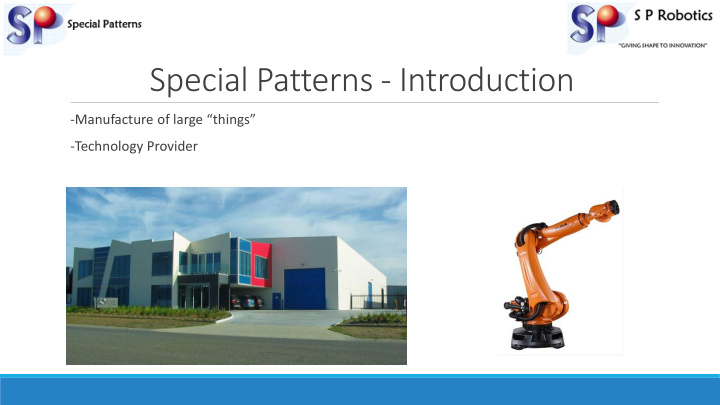



Special Patterns - Introduction - Manufacture of large “things” -Technology Provider
Deny Tanuwidjaja (M.EngElectronics and Control Systems) • 6 Years Robot programming • 4 Years Control systems programming • 5 Years Head of programming
David Tumino (B. Eng. Robotics & Mechatronics) • 5 Years CNC field engineering • 4 Years machine design / robotic system design • 5 Years Operations Manager / Head of Engineering
Special Patterns Started in 1973 Traditional Pattern Making Early adopter of first CNC machines 6 x CNC machines and the largest being a 5 axis Macro Craftsman. Work envelope Of X 3200 Y 2500 Z 1000
Special Patterns Robot Fabrication Cell • Main focus is combining Hot wire cutting and milling on the same workpiece to increase productivity • Flexible • Constantly adapted to the current job.
The robotics division of Special Patterns Established to focus on Robotic Milling and Fabrication Design and build bespoke robot system Known for out of the box thinking with machine design
Over 70 Robots… Over 30 Spindles…
Cobots Overview 2 types of collaborative robots TYPE 1: Force sensing TYPE 2: Area monitoring Limited model range in market place Growth area, we can expect to see more new models or cobots over the next few years
How Can CAM apply to cobots? TYPE 1: Force sensing Limited type of end effectors that are “Safe” Not Safe: • Glue / sealant dispensing • Miling • Hotwire cutting • Drawing / Art • Anything with a sharp edge! • 3d Printing • Pick / Place grippers
How Can CAM apply to cobots? TYPE 2: Area Monitoring Less restrictions on end effectors • Glue / sealant dispensing • Drawing / Art • 3d Printing • Pick / Place grippers • Milling • Hot Wire Cutting
How Can CAM apply to Cobots? RISK ASSESMENT ALYWAYS APPLYS
Robot Offline Programming Introduction There are 3 levels of offline programming available: Tier 1 – SprutCAM, Robotmaster, PowerMill Robot ◦ High end Robot CAM software Tier 2 – Grasshopper / KUKA PRC, ◦ Open platform, university development tool Tier 3 – KUKA Sim Pro, ABB Robot Studio ◦ Simulation and robot reach functionality
Robot Offline Programming Tier 1 Tier 2 Tier 3 • Used for checking Create robot programs Built-in robot pathing to follow by CAD functions in selected CAD model features layout and visual Grasshopper (mainly surface and curves) simulation • No pathing function, Open platform (user can In general can generate path user create points create custom function) for the following applications same as manual ◦ Milling No built in pathing and programming ◦ Trimming optimisation ◦ Welding ◦ Spraying
SprutCAM highlights Simple steps to create tool path 1. Select part feature by clicking the curves that is going to be trimmed
SprutCAM 2. Parameter settings to optimise pathing
SprutCAM 3. Software generates path
SprutCAM highlights 3. Simulate path and review collisions. 4. Fine tune angles to avoid collision and make smooth transitions
Robotic Trimming Video https://youtu.be/ls3v14YhkSg
SprutCAM highlights 5. Spraying and additive functions also available
KUKA PRC / Grasshopper Highlights Open source, high level programming targeted at the Creative Industry and Universities. Grasshopper language knowledge required for programming Example image for a relatively simple part trimming
KUKA PRC / Grasshopper Highlights For a single part, need to adjust the CAD features (curves, surface and meshes) to create the desired path behaviour.
KUKA Sim Pro Highlights Native software from KUKA Relatively simple to reach check and layout presentation.
KUKA Sim Pro Highlights No pathing capabilities. To program path need to manually snap to position, adjust angles and compensate for tool diameter
Combining Technologies - Robots are flexible but do have limits - CAM software pushes the robots limits - with CAM different cutting techniques can be combined - 3d printing also a reality - Hybrid cutting
HYBRID Cutting – EPS Foam Combining Hot Wire Cutting with CNC machining “Roughing” can now be done 80% faster Straight to finish pass
Hybrid Cutting Video https://youtu.be/0_oVejBXe0c
Accuracy of Robotic Milling Robots are Repeatable but are not accurate Understanding this will help make your robot programs more accurate!
Accuracy of Robotic Milling Robots are Repeatable but are not accurate Understanding this will help make your robot programs more accurate! ROBOTS
Why? Robot rigidity / stiffness Robot kinematics 6 motors combine to make a straight line But there is constant improvement from the robot manufactures 2009 KR210kg 2.7m reach robot flexed 1.1mm with 70kg loading 2016 KR120kg 2.9m reach robot flexed 0.7mm with 70kg loading Why? Better material science and robot construction
KUKA KR120 R2900 Robot Accuracy Test Absolute Accuracy spec. Equipment KUKA.CNC Controller
RESULTS 100% % of point t we were: +/- 0.32 97% of points ts were: +/- 0.25 Min value: e: -0.322 22 Max value: e: 0.229 29 Mean: -0.07
CAM to Real World Example - Video Customer tolerance ±0.5 3d complex shapes Probe verification of cut lines and drilled holes Programed tool paths were “shifted” to the correct position
Carbon fibre Trim Video https://youtu.be/lsZ93bwCmPg
Collisions and Singularities in CAM What is a Robot Singularity? Robots can achieve the same TCP position with different joint positions
Live SprutCAM Demonstration:
Thank you! facebook.com/SpecialPatterns/
Recommend
More recommend